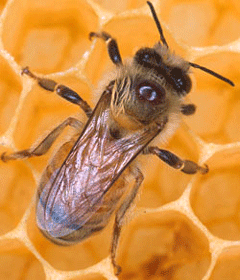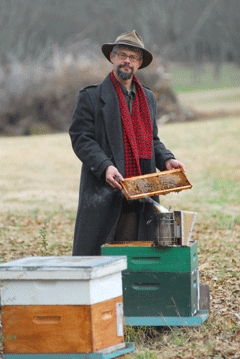Pollinator Problems
Air Date: Week of April 27, 2007

A honeybee (Courtesy of NIH)
Honeybee populations are on the decline and scientists are racing to find the reason. They recently gathered to discuss the mysterious phenomenon called Colony Collapse Disorder. Entomologist Keith Delaplane tells host Jeff Young about the possible causes of the pollinator problems.
Transcript
YOUNG: It’s Living on Earth. I’m Jeff Young. It’s planting season around much of North America. And before long, crops all over the continent will need swarms of honeybees to pollinate the flowers so they can produce about a third of our food. But as we recently reported, those swarms are getting smaller. Roughly a quarter of America’s 2.4 million honeybee colonies have been lost in recent months. Honeybees are in trouble both here and abroad and no one knows exactly why.
This past week brought a summit on what’s come to be called Colony Collapse Disorder. Keith Delaplane was part of that discussion. He’s an Entomologist at the University of Georgia and Senior Editor of the Journal of Apicultural Research. Professor Delaplane says the meeting was the first real opportunity for experts from around the U.S. to compare the latest findings on the honeybee problem.
DELAPLANE: The common thread was to try to get a handle on the reality and the extent of colony deaths. And also there’s a real interest in trying to identify possible causes and their interactions. And then finally draft a list of research priorities that could be fundable and researchable and try to get some real answers.

Keith Delaplane with his honeybees. (Courtesy of Keith S. Delaplane)
DELAPLANE: We have a good idea of potential causes. In fact most of them are old things that we’re familiar with from years of honeybee problems. A lot of this goes back to the 1980s when there were exotic honey bee parasites that came to our shores, a couple of parasitic mites.
YOUNG: So it might be the mites?
DELAPLANE: It might be the mites. I’m pretty sure it’s the mites. But there’s other things too. And there’s other disease-causing agents some of which are not even possibly identified or understood. And there’s other management factors that certainly play a negative role. It’s helpful to remember that commercial bee keeping is rough. It’s rough on the beekeeper, it’s rough on the bees. They’re loaded on trucks in the middle of the night. They’re trucked miles and miles from coast to coast and this is stressful on the bees.
YOUNG: Huh, so over-worked honey bees. Is that what you’re talking about?
DELAPLANE: It’s possible to over-work even the busy bee.
YOUNG: (laughs) And so they’re moving them all around, that’s not necessarily causing them to die but it’s stressing them and making them more vulnerable.
DELAPLANE: Exactly. We have evidence that when you add a succession of stresses onto the honeybee colony it takes very little additional stress to tip a colony over the top. You have one parasite that’s bad. You have another parasite that’s bad. Let’s add a disease, a pathogen, let’s add poor nutrition. Now let’s load it on a truck and move it in the middle of the night, maybe we shouldn’t be surprised that some of these colonies are dying.

A honeybee (Courtesy of NIH)
YOUNG: So what about pesticides or other chemical toxins?
DELAPLANE: Pesticides are an age-old enemy of bee keeping. Fortunately the classes of chemicals that are used in recent years tend to be less acutely toxic. So we’re not seeing large dramatic bee kills like we were accustomed to in the 1960s and 70s. That’s the good news. The bad news is a lot of the new chemistry that we’re using has more subtle sub-lethal effects that are still there but hard to detect. The best example of this is some new classes of chemistry that impairs the bee’s cognitive ability. When it comes to honey bee’s cognitive ability one of the most important things is your ability to find your nest. If you’re out flying, visiting flowers can you find your home again? And a lot of these new chemicals do impair the bee’s ability to return to their nest and this is subtle. It’s very easy to overlook. And what the beekeeper sees is just a dwindling colony population.
YOUNG: And I understand that, aside from this new phenomena, pollinators in general haven’t been doing very well.
DELAPLANE: This is a systemic problem that transcends bee keeping and honey production. It also involves more than honeybees. Because we have in general an increasing acreage of pollinated crops at the same time that we’re have a decrease in the density of our pollinators. And this is creating a pollinator deficit that is of broad societal concern. Cause, literally the quality of diet that we enjoy in the developed world are very largely dependent of bee-pollinated plants.
YOUNG: Are we asking too much of the honeybee here? Should we be looking at other possible pollinators to help out if the honeybee is hurting?
DELAPLANE: I fully agree with that. We have a large number of native bee species here in North America. Most of them are overshadowed by the honeybee, which is by the way an alien species, it was imported here from Europe in the 1600s. But these native, solitary, and bumblebees that exist here in North America are themselves important contributors to our food supply and the pollination chain. Our knowledge of them has lagged behind our knowledge of the honeybee simply because they are not as manageable and therefore not as easy to study.
YOUNG: Now you mentioned the bumblebee as a possible back up, the plan B. What about other insects, other animals all together that pollinate. Are they options?
DELAPLANE: Surely there’s plenty of other animals that visit flowers. And any animal that visits a flower, including some physical forces like rain and gravity, all of these are viable pollen vectors. The reason bees in general sort of rise to the top on these lists is the fact that they are extremely efficient at what they do. They’re basically flying fuzz balls, and the pollen sticks to their bodies very readily. They have a natural affinity for flowers, where as a lot of insects just visit them accidentally. So yes, other pollinators are viable and certainly to be encouraged but nothing will ever replace bees.
YOUNG: Professor Keith Delaplane thank you very much for speaking with us.
DELAPLANE: Thank you for having me.
Links
Living on Earth wants to hear from you!
Living on Earth
62 Calef Highway, Suite 212
Lee, NH 03861
Telephone: 617-287-4121
E-mail: comments@loe.org
Newsletter [Click here]
Donate to Living on Earth!
Living on Earth is an independent media program and relies entirely on contributions from listeners and institutions supporting public service. Please donate now to preserve an independent environmental voice.
NewsletterLiving on Earth offers a weekly delivery of the show's rundown to your mailbox. Sign up for our newsletter today!
 Sailors For The Sea: Be the change you want to sea.
Sailors For The Sea: Be the change you want to sea.
 The Grantham Foundation for the Protection of the Environment: Committed to protecting and improving the health of the global environment.
The Grantham Foundation for the Protection of the Environment: Committed to protecting and improving the health of the global environment.
 Contribute to Living on Earth and receive, as our gift to you, an archival print of one of Mark Seth Lender's extraordinary wildlife photographs. Follow the link to see Mark's current collection of photographs.
Contribute to Living on Earth and receive, as our gift to you, an archival print of one of Mark Seth Lender's extraordinary wildlife photographs. Follow the link to see Mark's current collection of photographs.
 Buy a signed copy of Mark Seth Lender's book Smeagull the Seagull & support Living on Earth
Buy a signed copy of Mark Seth Lender's book Smeagull the Seagull & support Living on Earth

